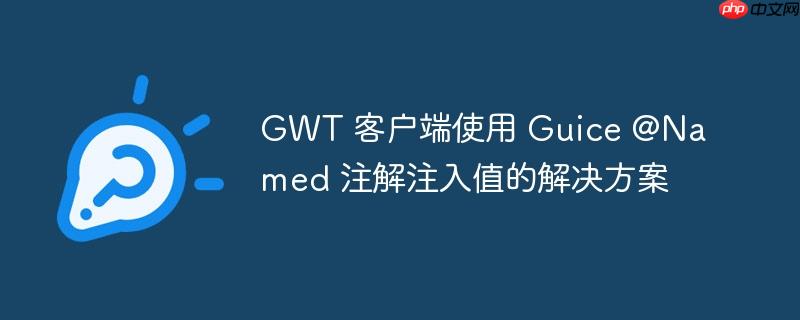
本文旨在解决在 GWT 客户端代码中使用 Guice 的 @Named 注解进行依赖注入时遇到的问题。由于 GWT 客户端环境的特殊性,直接使用 Guice 注入静态值会引发错误,例如 "You are executing Names.named() in GWT code" 以及 "Binding requested for constant key... but no explicit binding was found"。本文将介绍两种解决方案:使用 AbstractGinModule 在客户端绑定静态值,以及使用 GWT RPC 从服务器端获取动态值,从而规避客户端直接使用 Guice 的限制,实现依赖注入。
由于 GWT 客户端无法完整模拟 Java 环境,直接使用 Guice 的 @Named 注解进行注入会导致错误。解决这一问题的关键在于使用 AbstractGinModule 在客户端进行绑定。
以下是一个示例:
创建 Gin 模块:
创建一个类继承 AbstractGinModule,并在 configure() 方法中进行绑定。
import com.google.gwt.inject.client.AbstractGinModule;
import com.google.inject.name.Names;
public class MyGinModule extends AbstractGinModule {
@Override
protected void configure() {
bindConstant().annotatedWith(Names.named("endpoint")).to("Endpoint URL");
}
}在 GWT 模块中引入 Gin 模块:
在你的 GWT 模块的 *.gwt.xml 文件中,添加 Gin 模块的引用。
<module rename-to='mymodule'> <!-- Inherit the core Web Toolkit stuff. --> <inherits name='com.google.gwt.user.User'/> <!-- Inherit the Gin module. --> <inherits name="com.google.gwt.inject.Inject"/> <!-- Other module settings... --> <source path='client'/> <entry-point class='com.example.client.MyEntryPoint'/> </module>
使用 @Inject 和 @Named 注解:
在你的 GWT 客户端代码中,使用 @Inject 和 @Named 注解来注入值。
import com.google.gwt.core.client.GWT;
import com.google.gwt.uibinder.client.UiBinder;
import com.google.gwt.user.client.ui.Composite;
import com.google.gwt.user.client.ui.Widget;
import com.google.inject.Inject;
import com.google.inject.name.Named;
public class MyUIPanel extends Composite {
private static MyUIPanelUiBinder uiBinder = GWT.create(MyUIPanelUiBinder.class);
interface MyUIPanelUiBinder extends UiBinder<Widget, MyUIPanel> {
}
@Inject
@Named("endpoint")
private String endpoint;
@Inject
public MyUIPanel() {
initWidget(uiBinder.createAndBindUi(this));
// Use the injected endpoint value
GWT.log("Endpoint: " + endpoint);
}
}注意: 你需要使用 Gin 来创建 MyUIPanel 的实例,而不是使用 new MyUIPanel()。 通常,你需要在你的 EntryPoint 中使用 GinInjector 来获取实例。
import com.google.gwt.core.client.EntryPoint;
import com.google.gwt.core.client.GWT;
import com.google.gwt.user.client.ui.RootPanel;
import com.google.inject.Guice;
import com.google.inject.Injector;
public class MyEntryPoint implements EntryPoint {
@Override
public void onModuleLoad() {
Injector injector = Guice.createInjector(new MyGinModule());
MyUIPanel myUIPanel = injector.getInstance(MyUIPanel.class);
RootPanel.get().add(myUIPanel);
}
}对于需要从属性文件或数据库动态获取的值,不能直接在客户端使用 Guice 注入。 解决方案是将获取动态值的逻辑放在服务器端,然后通过 GWT RPC 将值传递给客户端。
以下是一个示例:
定义 RPC 服务接口:
import com.google.gwt.user.client.rpc.RemoteService;
import com.google.gwt.user.client.rpc.RemoteServiceRelativePath;
@RemoteServiceRelativePath("endpointService")
public interface EndpointService extends RemoteService {
String getEndpoint();
}定义 RPC 服务接口的异步版本:
import com.google.gwt.user.client.rpc.AsyncCallback;
public interface EndpointServiceAsync {
void getEndpoint(AsyncCallback<String> callback);
}实现 RPC 服务接口:
import com.google.gwt.user.server.rpc.RemoteServiceServlet;
public class EndpointServiceImpl extends RemoteServiceServlet implements EndpointService {
@Override
public String getEndpoint() {
// Logic to fetch endpoint from properties file or database
return "Dynamic Endpoint URL from Server";
}
}在 web.xml 中配置 Servlet:
<servlet> <servlet-name>endpointService</servlet-name> <servlet-class>com.example.server.EndpointServiceImpl</servlet-class> </servlet> <servlet-mapping> <servlet-name>endpointService</servlet-name> <url-pattern>/mymodule/endpointService</url-pattern> </servlet-mapping>
在客户端调用 RPC 服务:
import com.google.gwt.core.client.GWT;
import com.google.gwt.user.client.rpc.AsyncCallback;
import com.google.gwt.user.client.rpc.ServiceDefTarget;
public class MyUIPanel {
public void loadEndpoint() {
EndpointServiceAsync endpointService = GWT.create(EndpointService.class);
ServiceDefTarget endpoint = (ServiceDefTarget) endpointService;
endpoint.setServiceEntryPoint(GWT.getModuleBaseURL() + "endpointService");
endpointService.getEndpoint(new AsyncCallback<String>() {
@Override
public void onFailure(Throwable caught) {
GWT.log("Error fetching endpoint: " + caught.getMessage());
}
@Override
public void onSuccess(String result) {
// Use the endpoint value obtained from the server
GWT.log("Endpoint from server: " + result);
}
});
}
}在 GWT 客户端使用 Guice 进行依赖注入需要注意其特殊性。 对于静态值,可以使用 AbstractGinModule 在客户端进行绑定。 对于动态值,建议使用 GWT RPC 从服务器端获取。 这样可以避免客户端直接使用 Guice 引起的错误,并保证应用程序的正常运行。
注意事项:
以上就是GWT 客户端使用 Guice @Named 注解注入值的解决方案的详细内容,更多请关注php中文网其它相关文章!

每个人都需要一台速度更快、更稳定的 PC。随着时间的推移,垃圾文件、旧注册表数据和不必要的后台进程会占用资源并降低性能。幸运的是,许多工具可以让 Windows 保持平稳运行。

Copyright 2014-2025 https://www.php.cn/ All Rights Reserved | php.cn | 湘ICP备2023035733号